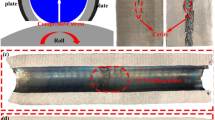Abstract
The rotary swaging process is a cold working process used to reduce the diameter, produce a taper or add point to a round workpiece. For the preform design of a swaged shell nose part by a rotary swaging process, finite element simulation and experimental verification have been carried out to obtain a shell body nose of desired quality. Reliability analysis for the occurrence of process-induced cracks is performed by fault tree analysis. The various process parameters such as initial nose thickness, feed distance and reduction diameter are applied for the fault tree in order to obtain the desired target dimensions. Through simulation, the effects of initial nose thickness on the swaged shapes are analyzed. With fault tree analysis, the risk of process-induced cracks was predicted by finite element simulation and the crack occurrence was verified by swaging experiment. The results show that a swaged shell nose part having higher reliability can be successfully produced by rotary swaging process.
Similar content being viewed by others
References
V. Piwek, B. Kuhfuss, E. Moumi and M. Hork, Light weight design of rotary swaged components and optimization of the swaging process, International Journal of Material Forming, 3 (2010) 845–848.
S. Yuan, X. Wang, G. Liu and D. Chou, The precision forming of pin parts by cold-drawing and rotary-forging, Journal of Materials Processing Technology, 86 (1999) 252–256.
S. J. Lim, H. J. Choi and C. H. Lee, Forming characteristics of tubular product through the rotary swaging process, Journal of Materials Processing Technology, 209 (2009) 283–288.
X. Han and L. Hua, Comparison between cold rotary forging and conventional forging, Journal of Mechanical Science and Technology, 23 (2009) 2668–2678.
S. W. Lee and H. K. Lee, Reliability prediction system based on the failure rate model for electronic components, Journal of Mechanical Science and Technology, 22(5) (2008) 957–964.
R. Ferdous, F. I. Khan, B. Veitch and P. R. Amyotte, Methodology for computer-aided fault tree analysis, Process Safety and Environmental Protection, 85(1) (2007) 70–80.
Y. C. Lee, K. S. Kim, J. H. Ahn, J. W. Yoon, M. K. Min and S. B. Jung, Effect of multiple reflows on the mechanical reliability of solder joint in LED package, Korean Journal of Metals and Materials, 48(11) (2010) 1035–1040.
M. Bayraktar, N. Tahrali and R. Guclu, Reliability and fatigue life evaluation of railway axles, Journal of Mechanical Science and Technology, 24(3) (2010) 671–679.
N. E. Kang, C. D. Yim, B. S. You and I. M. Park, Fracture behavior of AZ31-xCa (x=0, 0.7, 2.0 wt.%) extrudes during compression, Korean Journal of Metals and Materials, 48(1) (2010) 85–89.
S. Y. Kim, S. S. Kim and H. K. Choi, Remaining life estimation of a level luffing crane component by computer simulation, Korean Journal of Metals and Materials, 48(6) (2010) 489–498.
Author information
Authors and Affiliations
Corresponding author
Additional information
Recommended by Guest Editor Dong-Ho Bae
Jeong-Hwan Jang received his M.Sc. (2007) in Mechanical Engineering at Pusan National University, Busan, Korea. Since 2007, he has been pursuing Ph.D studies at the same university. His research interests are related to direct laser melting process of metal powder and material processing technology.
Young-Hoon Moon received his Ph.D in Metallurgical and Materials Engineering from Colorado School of Mines, Golden, USA. He is a professor at the School of Mechanical Engineering, Pusan National University, Busan, Korea. His research includes materials processing technology and reliability analysis.
Rights and permissions
About this article
Cite this article
Jang, Jh., Kwon, Wh., Chun, Sh. et al. Reliability analysis of process-induced cracks in rotary swaged shell nose part. J Mech Sci Technol 26, 2155–2158 (2012). https://doi.org/10.1007/s12206-012-0535-z
Received:
Revised:
Accepted:
Published:
Issue Date:
DOI: https://doi.org/10.1007/s12206-012-0535-z




